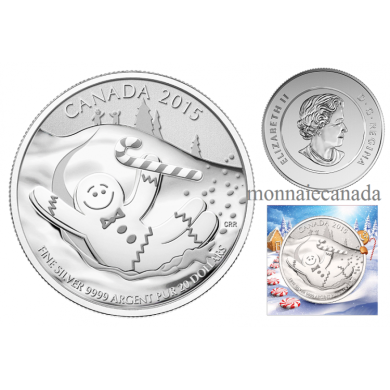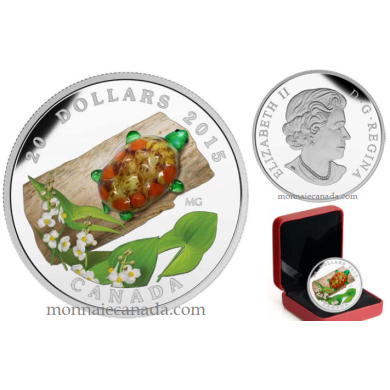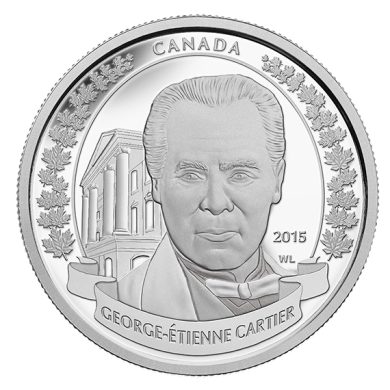Free shipping with purchases of $ 500 or more
2015 - $20 - 1 oz. Fine Silver Gold-Plated - First World War Battlefront: The Second Battle of Ypres
# B599
Stock: 2
Earn 100 points *
First World War Battlefront: The Second Battle of Ypres
"Imagine Hell in its worst form. You may have a slight idea of what it was like." (A Canadian Sergeant)
In April of 1915, the Allied front line formed a bulge around the Belgian town of Ypres to form what became known as the Ypres "Salient." The Germans occupied the high ground to the north, east, and south of Ypres from which they could view the Allied positions. The enemy saw it as an ideal location to break through the Allied lines.
The dawn of April 22, 1915 brought a bright, clear day.
For the soldiers of the Canadian First Division, it meant a relief from the rain and a warm welcome to springtime conditions. They had been repositioned to a quiet rear sector northeast of the town earlier that month, but now found themselves in the front-line within the Salient.
The Canadians had not yet been involved in a major engagement with the enemy—a challenge they eagerly wanted to meet so as to prove their mettle and worth. They would soon get their wish in the horrific baptism of fire that began on that warm spring day. Around late afternoon, the Canadians viewed a greenish cloud rolling towards their trenches and those of the French and Algerian troops on the left flank.
Soon they saw these troops abandoning their positions, desperately trying to escape from what soon proved to be the release of an estimated 160 tons of chlorine gas. Most—thousands—did not get far.
This opened up a huge gap in the Allied line. The Canadians adopted whatever measures possible to meet the oncoming gas and prepared to meet the German troops that were close behind. Although the Germans were able to break the Allied line at several points, they were unable to fully exploit their advantage due to the stubborn and courageous defence displayed by the Canadians.
Close quarter combat followed for days; attacks were followed by counterattacks. Throughout this, the Canadian Division was subjected to a constant, intense artillery barrage. Their tenacity along the Salient, at places such as Bois des cuisiniers, Gravenstafel, St. Julien, Festubert and Frezenberg Ridge, added to the proud history of the Canadian Army and many of its most storied regiments.
Although these actions earned the Canadians a fearsome reputation, sadly, it came at a tremendous cost. When withdrawn from the battle, the Division had lost over 6,000 dead and wounded from its initial strength of 10,000.
It was during this battle, shortly after the burial of his best friend, that a Canadian Army surgeon named John McCrae penned the immortal poem "In Flanders Fields." It would soon become the anthem for the remembrance of those who made the ultimate sacrifice in a war that would last for another three and a half years.
Specifications
No. 140830
Mintage 10000
Composition 99.99% pure silver with selective gold plating
Finish proof
Weight (g) 31.39
Diameter (mm) 38
Edge serrated
Certificate serialized
Face value 20 dollars
Artist Silvia Pecota (reverse), Sir E.B. MacKennal (obverse)
In April of 1915, the Allied front line formed a bulge around the Belgian town of Ypres to form what became known as the Ypres "Salient." The Germans occupied the high ground to the north, east, and south of Ypres from which they could view the Allied positions. The enemy saw it as an ideal location to break through the Allied lines.
The dawn of April 22, 1915 brought a bright, clear day.
For the soldiers of the Canadian First Division, it meant a relief from the rain and a warm welcome to springtime conditions. They had been repositioned to a quiet rear sector northeast of the town earlier that month, but now found themselves in the front-line within the Salient.
The Canadians had not yet been involved in a major engagement with the enemy—a challenge they eagerly wanted to meet so as to prove their mettle and worth. They would soon get their wish in the horrific baptism of fire that began on that warm spring day. Around late afternoon, the Canadians viewed a greenish cloud rolling towards their trenches and those of the French and Algerian troops on the left flank.
Soon they saw these troops abandoning their positions, desperately trying to escape from what soon proved to be the release of an estimated 160 tons of chlorine gas. Most—thousands—did not get far.
This opened up a huge gap in the Allied line. The Canadians adopted whatever measures possible to meet the oncoming gas and prepared to meet the German troops that were close behind. Although the Germans were able to break the Allied line at several points, they were unable to fully exploit their advantage due to the stubborn and courageous defence displayed by the Canadians.
Close quarter combat followed for days; attacks were followed by counterattacks. Throughout this, the Canadian Division was subjected to a constant, intense artillery barrage. Their tenacity along the Salient, at places such as Bois des cuisiniers, Gravenstafel, St. Julien, Festubert and Frezenberg Ridge, added to the proud history of the Canadian Army and many of its most storied regiments.
Although these actions earned the Canadians a fearsome reputation, sadly, it came at a tremendous cost. When withdrawn from the battle, the Division had lost over 6,000 dead and wounded from its initial strength of 10,000.
It was during this battle, shortly after the burial of his best friend, that a Canadian Army surgeon named John McCrae penned the immortal poem "In Flanders Fields." It would soon become the anthem for the remembrance of those who made the ultimate sacrifice in a war that would last for another three and a half years.
Specifications
No. 140830
Mintage 10000
Composition 99.99% pure silver with selective gold plating
Finish proof
Weight (g) 31.39
Diameter (mm) 38
Edge serrated
Certificate serialized
Face value 20 dollars
Artist Silvia Pecota (reverse), Sir E.B. MacKennal (obverse)
You may also be interested in these products
Keep in touch!
Subscribe to receive email specials and new products.
Come see us !
OPENING HOURS
Tuesday to Saturday - 9h00am - 4h00pm
Sunday - Monday - Closed
Tuesday to Saturday - 9h00am - 4h00pm
Sunday - Monday - Closed
Buying:
Coins & paper money
We buy coins and paper money as well as broken or unwanted gold jewellery.
- What to do and what not to do.
- How To Prepare your collection to be evaluated.









